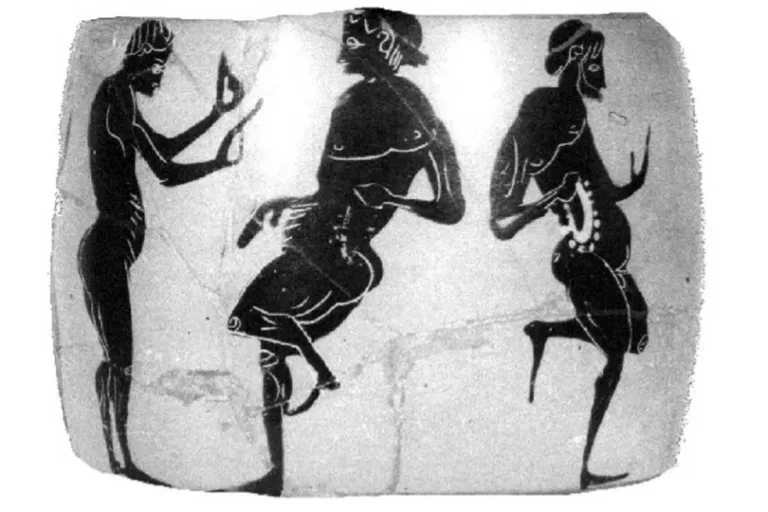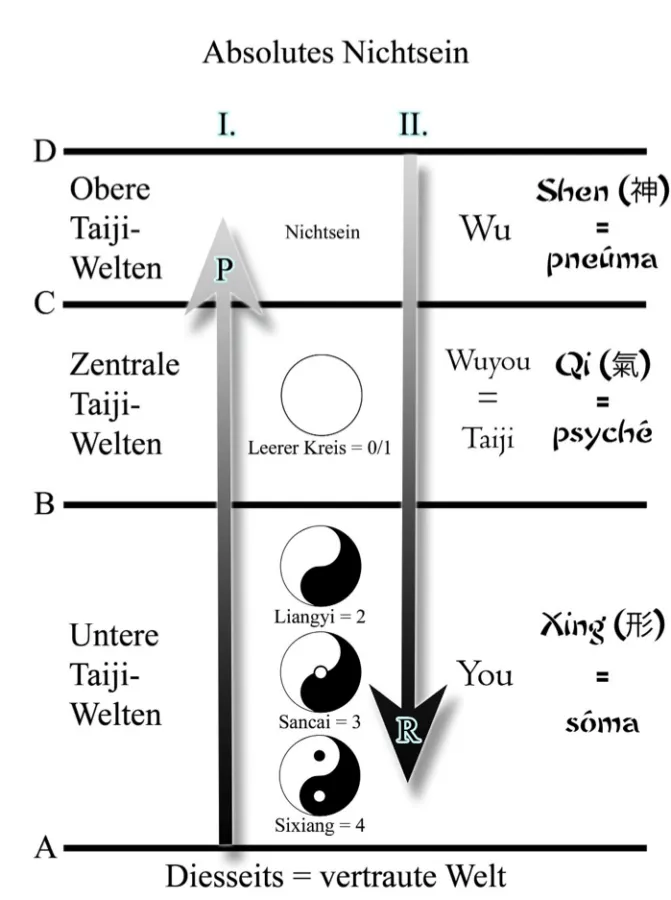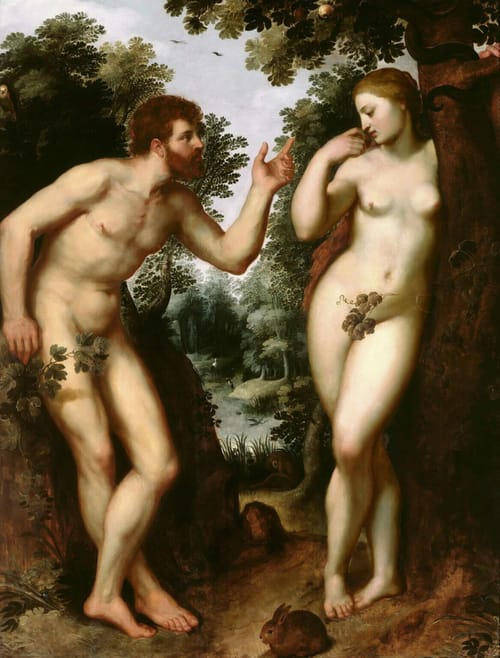Traditional knowledge about the soul
Philon of Alexandria (c. 25 BCE-45 CE), son of a rabbi, is considered the founder of Jewish philosophy. Like the Iranian Suhrawardi (1154-1191), author of the Hikmat al Ishraq (Philosophy of Enlightenment), he was familiar with the practice-based Pythagorean/Platonic philosophy. They both understood its metaphors and knew that Adam and Eve symbolized two contrasting facets of the soul within us, animus, the masculine, and anima, the feminine. They also knew that with the development of civilization, animus would decrease and anima, which predominantly shapes us today, would increase.
Both still belong to the wisdom seekers, who as early as shamanic times gained a more profound knowledge of the soul (psyché) through meditative introspection (picture 1) than we have today. This has been preserved until today in the “knowledge about Qi” in my Dao school (www.taijixue.de). It was discovered 10,000 years ago. I describe this in the book Der Glaubensfreie Universelle Erleuchtungsweg (DGUE)(The Faith-Free Universal Enlightenment Path). There I explain that psyché, which masters of philosophy discuss extensively, turns out to be the equivalent of Qi. What is it about?

Just as water is the generic term of the triplet (ice, water, steam), it is Qi for (Xing, Qi, Shen), translated as (body, Qi = life energy, spirit) and psyché for (sóma, psyché, pneúma), translated as (body, soul, spirit). This is one of many indications of Qi = psyché (soul), which to my knowledge has not been recognized until now.
Even more, just as water transforms from ice to steam and vice versa, the same happens, as I will show, in introspection for Qi = psyché. While water has three states of being, Qi is the mixture of Xing and Shen. Likewise, the psyché is the mixture of sóma and pneúma.
Ascent and descent of psyché
The perception of Qi in the Dao practice that I have been familiar with since 1997 (Figure 1) changes in three stages from Xing to Shen (arrow I in Figure 2). This brings forth all Dao knowledge (Taijixue) about the beyond (from A to D in picture 2). This likewise concerns, as I have realized, the perception of the psyché from sóma to pneúma in its equivalent practice (Fig. 1) of “philosophia”. Thus – in the ascent (anagogé) of the psyché (arrow I in Figure 2) – the knowledge (epistéme) is acquired that was lost in the descent (katagogé) of the psyché, the spiritual act of creation (arrow II in Figure 2). I wrote about the ascent in Noah’s Ark (TV 90) and the descent that was perceived with it in Fall of Atlantis (Tattva Viveka (TV) – German Magazine for Science and Spirituality). More details will follow here, which I will clarify in DGUE.

The illuminating practice of dying
Plato (428/427-348/347) calls the practice (Figure 1) that makes ascension (arrow 1 in Fig. 2) possible meléte thanátou (practice of dying) and assigns it the attribute phaidros (bright, illuminating). It appears to be the equivalent of the Dao practice.
It has nothing to do with reflection or contemplation of dying and death, as untrained interpreters of the philosophy claim. This is “poetry”, because “dying” is a metaphor for practicing (Fig. 1) and “death” for the enlightenment gained by it (“D” in Fig. 2).
On this Plato (Phaidon 64a) says: “Other people are probably not aware that those who correctly EXERCISE the philosophy do nothing other than ‘die’ and be ‘dead’.” Here he is referring to the world-avoiding practice (Fig. 1), which I also recently explained in TV 90 (Tattva Viveka).
Philosophy = With philía to sophía
Philosophy, translated as love of wisdom, originated through a lack of knowledge of the metaphors of “philosophia” recognized in the ascent of the psyché (arrow I), the original meaning of which is: with philía to sophía (wisdom). The philía experienced more and more in the ascent is far more profound than the love attributed to it. This also applies to the sophía gained with it, because successful practitioners recognize with the practice the progress which is made (P in figure 2): The (spiritual) heaven (ouranós) gives them “out of itself (kat’hauta)” the unique everlasting universal experiential knowledge (epistéme). This increases as they overcome their attachment to the earthly, “earth (gaía, A)”, in ascension. Genesis (1.28) refers to this: “Subdue the earth!”
The three immaterial regions of the body
The realm explored in ascension (from A to D) comprises – in the terminology of my Dao school – the three worlds (You, Wuyou, Wu) = (being, mixture of being and non-being, non-being) and their world contents (Xing, Qi, Shen). This was recognized by enlightened masters in introspection (picture 1): Xing is to be assigned to the immaterial (metaphorical) head space (Tian Men), Qi to the heart space (Jiang Gong) and Shen to the lower abdomen space (Di Fu). In my school, “The head is the tool of the heart (Xin).” What applies to the three-stage perception of qi (arrow I) also applies to that of psyché, which Suhrawardi calls nafs (see DGUE).
There is an old dispute
The “poetry” of philosophía includes (sóma, psyché, pneúma) = (body, soul, spirit) and philosophía = philosophy. This includes all translations of their metaphors, which, without practice reference, do not reflect what was originally behind them and needs to be experienced.
Plato refers to this (Politeia 259e): “There is an old dispute between philosophía and poetry.” He calls philosophía in Politeia (Rep. II 379a5f.) – albeit only once – theología. Aristotle calls it proté philosophía (first philosophy). In the Middle East, one encounters falsafah al-ula instead.
The “poetry” about the philosophía includes the anamnésis (recollection), aletheía (truth) and areté (virtue) cited below, insofar as ignoring that they refer to the ascent (arrow I), their experiential natures intensifying in the process. Likewise, kosmología (referring to the spiritual world origin), describes how the descent (arrow II), which equals the spiritual act of creation (Genesis).
“Poetry” about Adam and Eve
The “philosophia” (“theologia”), like the Dao teachings, Hikmat al Ishraq and falsafah al-ula, is couched in practice-related metaphors (parables, allegories), about which a lot of “poetry art” is produced and conveyed through their ignorance. I reveal this extensively in DGUE. There I show that the Qi (psyché) knowledge acquired in the EXERCISE of the Dao practice (of dying) again reveals what it hides.
There I reveal in detail the profound Adam-Eve-Myth (AEM) from Genesis (chapters 2 to 5), according to which Adam is considered the first man and husband of Eve. This myth is supposedly about the expulsion of Adam and Eve from paradise, because Eve is said to have seduced Adam.
However, as I demonstrate in DGUE, this is a major misinterpretation of what was originally behind the AEM. This results from the ascent (arrow I) of the psyché, which leads to enlightenment (D). The knowledge acquired in this way (epistéme) describes the spiritual act (arrow II), which is spoken of by masters from East and West with metaphors that have the same content. However, neither philosophy, theology nor science has been able to uncover what is hidden behind them, e.g. anamnésis, aletheía and areté. They all depend on the progress (P) made in the ascent (arrow II).

Adam and Eve are not individuals
As I show in DGUE, in line with Philon and Suhrawardi, who regard Jesus as enlightened, Adam and Eve are not individuals but allegories of the two facets, sóma and pneúma, of the psyché. This means that in the ascent (arrow I), the practitioner’s perception (Figure 1) changes in three stages from the sensually perceived (psyché =) sóma (Eve) to the super sensually experienced (psyché =) pneúma (Adam). In the descent (arrow II), the act of creation, the change takes place in the opposite direction (arrow I), as explained in the fall of Atlantis (TV 91).
This is part I of “Adam and Eve”. Part II you can find here.
Translated from German to English from Lynn Taylor.
